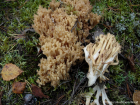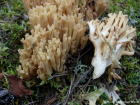Fruiting body ochraceous tinged buff, becoming darker with age, repeatedly branching coral-line with pointed forked tips. The branches are cylindrical or laterally compressed arising from a pallid stout stem. The flesh in the stem is white, glossy, elastic and tough, and in older fruiting bodies, gelatinous. Spore print yellow or ochre.
Microscopic Features: The spores are warty, cylindrical, approximately 7.5–9 × 4–4.5 µm in size.
Similar species: The Ramaria genus comprises approximately 200 species of which many are so similar to each other that they can be distinguished only with a microscope.
Ramaria genus on Wikipedia.
Many mushrooms are poisonous, and some can be lethally toxic. Distinguishing between edible and poisonous mushrooms can be very challenging. Therefore, we strongly advise against consuming wild mushrooms. This website does not contain any information about the edibility or toxicity of mushrooms.
Although efforts have been made to ensure accuracy on this website, the information may contain errors and omissions. Therefore, all content provided is for educational and informational purposes only and should not be relied upon or used as a basis for consuming any plants or mushrooms.
External links are provided for reference only. We do not endorse or take responsibility for the content, advice, or products found on these sites or in any advertisements shown on this website.

